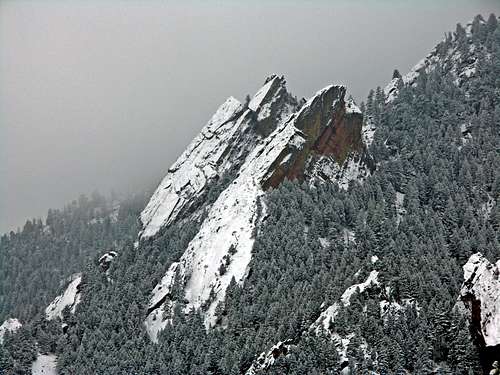|
|
Route |
|---|---|
|
|
39.96838°N / 105.28803°W |
|
|
Trad Climbing |
|
|
Spring, Summer, Fall, Winter |
|
|
Half a day |
|
|
5.4 (YDS) |
|
|
5 |
|
|
II |
|
|
Overview
Seal Rock is one of the most characteristic formations in the Flatirons. Beautiful from all sides, it hosts routes that range in difficulty from 5.4 to 5.14. The large east face features two very good slab climbs along its edges. Here we describe the shorter and harder of the two, which follows the south (left) edge. While the technical difficulties are comparable, the southern route is harder to protect and this is probably why it is less popular.Getting There
From the NCAR parking lot at 6040 ft, follow the signs for southbound Mesa Trail. Continue on the Mesa Trail until the Bear Canyon Trail forks on the right. Now watch out for the unmarked Harmon Cave Trailhead on your right. If you reach the start of the Fern Canyon Trail, you've gone too far.Climb the steep escarpment of the Mesa Trail and follow the Harmon Cave Trail. The cave is a steep quarter of a mile from the trailhead. The gate that blocks access to the cave is a real eyesore, but the bats don't seem to mind.
The trail forks immediately before the cave. Follow the left branch, which continues to ascend towards the summit, until you reach the base of Seal Rock. The trail here forks again and the left branch, now a faint climber's path, contours the east and south sides of Seal Rock as it goes around the Pup. The Pup is a flatironette leaning against the lower part of the Seal's east face. The start of our route is at the corner formed by the south face of the Pup and the east face of the Seal.
Route Description
We climbed this route in 5 short pitches to avail ourselves of convenient belay spots.P1: Climb the irregular crack at the corner between the Seal and the Pup for 25-30 feet. The crack can be protected by large cams, but the rock here is rather crumbly. Before it becomes covered by lichens, make a committing traverse left to the open face and run it out to a tree on a small ledge directly above you (5.4 R).
P2: From the tree, traverse left gaining some elevation while aiming for the south face. In a smooth shallow groove you should find a large chickenhead that provides a convenient belay anchor. Climbing is no harder than 5.2, but protection is hard to place. I ended up running out the whole 40 m.
P3: Go straight up from the chickenhead on rock that is steeper, but more featured. Belay at a spacious ledge after about 35 m (5.2).
P4: Continue up for a short pitch to another comfortable ledge (5.3).
P5: Go briefly up until you reach the southeast ridge of Seal Rock at a notch. Here you may see an old rappel anchor overlooking the south face. Continue along the easy ridge to the summit (Class 4).
The vast expanse of sandstone that makes up the east face of Seal Rock allows many variations. In particular, the line described here is disjoint from the more popular East Face North route, but it is possible to reach it by trending right.
Descent
From the summit descend the north edge of the east face for about 20-30 feet to a deep notch. On the east face of the notch you'll see a two-bolt anchor with (usually) several slings and rap rings. This is the top anchor of the Sea of Joy route (5.13a). The rappel will deposit you at the base of the north face after 50 exciting meters.The middle third of the rappel is free hanging. Be warned: a single rope--even a 70 m rope--will not touch ground. For most climbers, this rappel provides an opportunity to see what 5.13 looks like from up close.
Once on the ground, follow the steep climber's trail that descends to Harmon Cave and the Mesa Trail.





